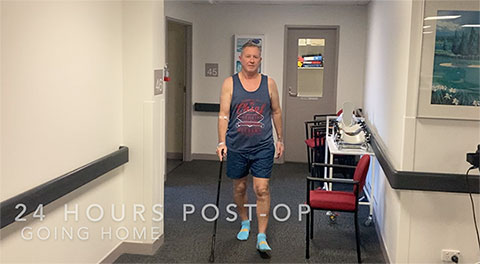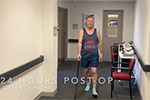
Over the last two years I have introduced an Enhanced Recovery After Surgery (ERAS) pathway for hip replacement surgery at Sportsmed Hospital. This is a patient focused evidence-based team approach to hip replacement surgery that speeds up recovery and reduces pain and complications. Every aspect of patient care has been carefully evaluated and the patient is involved as an active participant in the process.
As a surgeon the humbling thing is that surgical technique plays a relatively minor role in enhanced recovery pathways and these results are mainly achieved by assembling a dedicated multidisciplinary team focused on providing the best patient care and experience. The key factors involved are specialised anaesthetic techniques, multimodal opioid sparing pain relief, and modern nursing and physiotherapy care that reduces pain and enables early walking.
The process starts well before surgery with education. My team and I will discuss your expectations and ensure you are fully informed and prepared for surgery. Consultations are arranged with the anaesthetist and physician to assess and discuss any anaesthetic or medical issues. This helps with education and also makes the surgery safer.
On the day of surgery you will be advised to remain hydrated continuing clear fluids until 2 hours before the procedure. Most patients will have a spinal anaesthetic and light sedation. Drains are avoided. Patients should wake up with no pain. Oral pain relief is commenced early, with minimal opioids to reduce nausea and sedation. After a few hours the spinal anaesthetic wears off and patients are assisted to walk, with the aim of walking twenty metres using a frame on the day of surgery. This helps prevent the joint becoming stiff and sore. Pain is usually manageable with oral pain relief and is often less than patients had before the surgery. Strong narcotics are not usually required.
Traditionally surgeons have told patients to restrict their movements after hip replacement surgery because of concern about hip dislocation. Using the Enhanced Recovery pathway and modern minimally invasive surgical approaches this is usually no longer required. Earlier mobilisation allows faster recovery of muscle strength and this helps maintain hip stability. Patients can sit and sleep in whatever position is comfortable and can drive when they can safely control the car. This is often four weeks after a right hip replacement surgery.
Using this pathway most patients choose to spend only one to three nights in hospital and are able return to independence and activity more quickly. This can of course be adjusted based on a patient’s individual circumstances and recovery. There will always be some individual variation.
An example of what can be achieved is shown in this video:
Many other factors contribute to the success of enhanced recovery pathways. Every member of the team is involved including the patient, family, surgeon, anaesthetist, physician, physiotherapist, nurses and admin staff. We have carefully evaluated every aspect of the patient journey from the time of booking until full recovery to provide the best patient care and experience. A full list of these factors is detailed below.
If you would like to discuss hip replacement surgery with Dr Bauze then send us an email using the form on this page or call 81301259
For more information on hip replacement surgery click here
ENHANCED RECOVERY HIP REPLACEMENT SURGERY PATHWAY
Education Before Surgery
- Dr Bauze will explain the process and discuss your expectations
- Anaesthetist will discuss the recommended anaesthetic and pain relief options
- Nurse led education session is provided
- Dr Bauze’s personal assistant will be a single point of contact to help with all the administrative details, investigations and appointments
Medical Optimisation
- A Physician/Medical Specialist assessment will assess any medical issues you may have can manage these in hospital after your surgery
- Key factors in reducing complications are ceasing smoking (every day counts), moderating alcohol intake and correction of anaemia (if applicable)
- Antibiotic nasal ointment will be provided and should be used twice daily for the 5 days before the day of surgery to reduce infection risk
- 2 Antiseptic sponges are been provided for you to use, one the night before and the other the morning of surgery. Wash the operative site first, then the remainder of the limb followed by the rest of your body, then rinse off
- Cease aspirin, anti-inflammatories, herbal supplements and any specific other medications as directed by your surgeon, physician/medical specialist or anaesthetist
Admission Day
- Admission time to be confirmed the business day before surgery
- Take regular medications unless advised otherwise by physician or anaesthetist
- Present to the hospital reception desk on admission
- Bring ring the following:
- Relevant X-Rays
- Your medications in their original packages
- Loose fitting daytime clothing, sleepwear, flat footwear and toiletries
- To ensure you remain hydrated continue drinking clear (see through) fluids (water, black tea, clear apple juice etc. – NO MILK/DAIRY /cloudy fluids) and then cease these 2 hours before your scheduled surgery time.
Anaesthetic
- Usually this will be a single injection spinal anaesthetic – this is a combination of local anaesthetic and a narcotic which will assist you in waking up with minimal pain. You will be offered sedation, so you sleep lightly through the surgery.
- Medications are given to prevent nausea and vomiting.
- Medication to reduce bleeding
Surgery
- Takes approximately one and a half hours.
- Drains are not used routinely but may occasionally be required.
- Dr Bauze will discuss his recommended techniques with you before the surgery.
- Specific surgical techniques (e.g., anterior or posterior approach, robotic surgery or computer navigation) will not affect you getting out of bed and moving as soon as possible.
After Surgery
- You will spend approximately one hour in our recovery room after your surgery, to make sure you are comfortable before returning to your room on the ward.
- Eating and drinking as soon as possible is encouraged.
- A few hours after surgery, when the spinal anaesthetic has worn off, the physiotherapist or ward staff will help you get out of bed and walk.
- You will receive help with tasks such as washing, dressing, and walking to the toilet, but the aim is for you to become as independent as possible, as soon as it is safe to do so. The aim is to be able to walk twenty metres, get to the toilet with minimal assistance, and sit out of bed for meals.
Pain Relief
- The aim is for your pain to be manageable and allow early walking and independence.
- The key to early walking and recovery is taking a variety of pain relief medications.
- There will be minimal use of strong opiates
- Regular paracetamol and anti-inflammatory medication will be provided
- Oral mid strength pain relief will be administered for moderate pain
- If you do experience severe pain then stronger painkillers are available but these are often not required
Deep Vein Thrombosis Prevention
- Getting you out of bed and walking on the day of surgery is important.
- You will be given blood thinning injections while you are in hospital which help to reduce the risk of blood clots forming in your blood.
- You will need to wear anti-embolic compression stockings for 2 to 6 weeks.These are specially designed stockings that help reduce the risk of developing a deep vein thrombosis, (also referred to as a DVT), or blood clot in your lower leg after your surgery, while you are less active than normal. A DVT can sometimes lead to a more serious condition called a pulmonary embolism (blood clot in the lungs); wearing anti-embolic compression stockings helps to the reduce the risk of this happening.
- You will need to take Aspirin 300mg after discharge for 6 weeks, unless otherwise directed by your Doctor
Hip Replacement Precautions
- Enhanced Recovery Pathways allow earlier return of muscle strength and reduce the risk of dislocation with both anterior and posterior surgery approaches.
- Traditional restrictions on hip movements are therefore no longer usually required.
Discharge From Hospital
- Planning for this will start before admission to hospital
- If you live alone you will be able to go home safely when you can walk 20m, get dressed and go to the toilet independently. If you have someone who can help at home then you may go home when you can do these things with minimal assistance.
- Most people can expect this to be possible from one to three days after surgery.
- Some patients may require longer in hospital or some time in rehabilitation and this can be arranged if needed.
- You may resume driving once you can perform an "emergency stop" and are no longer taking regular strong analgesia. For most patients this is 4 to 6 weeks after a right leg hip or knee replacement.
- Maintaining good oral health is recommended. Many surgeons advise avoiding routine dental procedures for three months after having a hip or knee replacement and to have antibiotics if a higher risk dental procedure is required.
After Discharge
- Depending on your needs, where you live, when you go home and your health fund a home visit from a nurse and physiotherapist may be arranged
- 24-hour phone support is available and if you experience any problems, we encourage you to contact us so that we can assist.
- An early appointment one to two weeks after surgery will be arranged with Dr Bauze to assess wound healing and provide any further advice, prescriptions and treatment.
- Ongoing physiotherapy is recommended and can be arranged for the same time
- Dr Bauze will see you again at 6 weeks by which stage most patients have fully recovered, and provide ongoing follow up as needed.
Reference:
- Wainwright TW, Gill M, McDonald DA, Middleton RG, Reed M, Sahota O, Yates P, Ljungqvist O. Consensus statement for perioperative care in total hip replacement and total knee replacement surgery: Enhanced Recovery After Surgery (ERAS®) Society recommendations. Acta Orthop. 2020 Feb;91(1):3-19.
- van der Weegen W, Kornuijt A, Das D. Do lifestyle restrictions and precautions prevent dislocation after total hip arthroplasty? A systematic review and meta-analysis of the literature. Clin Rehabil. 2016 Apr;30(4):329-39.







